“Today’s software is so creative and seductive that it is easy to think that’s all there is to creating engaging content. Angie Taylor’s book shows the other side of the story: the visual techniques and design principles that underpin digital moving image making. In this comprehensive guide she has assembled a wealth of tips and exercises in topics such as drawing, composition and typography that will be required reading for all up-and-coming motion media artists.”
Birgitta Hosea, Artist and Course Director of MA Character Animation, Central Saint Martins College of Art and Design, London.
“Of all the After Effects books I looked at whilst trying to learn it,
I found Angie’s was the most user friendly and creative.”
Chris Cunningham, Director of music videos, commercials and video art.
“…a worthwhile investment for animators and artists who want to
focus on creating their designs and not get bogged down in
technical jargon… Angie has a knack for demystifying the intricacies
of After Effects and coming up with creative uses of the features.”
Steve Kilisky, Senior Product Manager, After Effects, Adobe Systems Inc.
“Angie Taylor’s work is inspired. She is a highly creative animator – inventive, witty and naturally sympathetic to individual programme styles”.
Carys Edwards, Director, Children’s BBC
“Angie Taylor is the best After Effects teacher I know. She goes beyond technical descriptions of features, and shows you how to best use them in real world projects.”
Bruce Bullis, Senior API Engineer, Adobe Dynamic Media, Adobe Systems Inc.
“This book takes you on a rollercoaster ride through the world of creating animation and special effects with Adobe After Effects. It is much more than just a software manual, Angie Taylor seeks to stimulate the creative use of computer animation. Complex technical issues are clearly and concisely explained, making it suitable for beginners as well as the more advanced users”.
Birgitta Hosea, Course Director, London Animation Studio, Central St. Martins College of Art and Design, London.
“…one of my favorite demo artists in the industry. Her tutorials
are always compelling, well-designed, and worthwhile.”
Brian Maffit, Creative Director, Total Training
“Angie is an outstanding guru of After Effects…her seminars
brings gasps of awe from seasoned and beginner audiences
alike… you will enjoy this book immensely.”
John Keedwell, GBCT, GTC. British Cinematographer
Recently a few people have been asking me about my blog. “What is it?” “Why do you do it?” “What is it for?” The funny thing is that most of these questions come to me via my Facebook page. This made me realize that there’s an ironic ignorance surrounding blogs by the general public. Ironic because Blogging is basically what everyone’s doing when they post information on their Facebook page.
The definition of blogging, according to Wikipedia, the free, collaborative online dictionary is this; “A blog (a contraction of the term “web log“) is a type of website, usually maintained by an individual with regular entries of commentary, descriptions of events, or other material such as graphics or video.”
People’s first experience with posting content online is often with the ubiquitous Facebook (or other social networking website). Hardly surprising, they provide users with simple methods for getting stuff online easily, no programming involved! You can create your own free account, upload messages, links, pictures and videos. Everything’s taken care of for you, you don’t have to do any site maintenance and most of the latest web technologies are implemented as and when they become available. But all this comes at a price, it’s a double-edged sword. These sites don’t provide all this for nothing so how do they make a profit by providing you with all this free stuff? (I’ll use Facebook as an example from this point on as it is currently the one most people will be familiar with but all these sites operate in similar ways.)
The simple answer is advertising. Facebook has built up a huge number of users. At the time of this blog there were more than 400 million users with an average of 50% active each day – a captive audience of sitting ducks just waiting to be sold stuff! As you can imagine this is extremely attractive to advertisers, they can hit millions of people very easily.
Facebook’s database must be one of the biggest and most lucrative in the entire world. By posting stuff on your Facebook page, you allow them to build up a detailed profile of you, so that advertisers can target their business towards your individual preferences and interests. If you’re not careful with your privacy settings, these personal details can also be passed on to other businesses making even more profit for Facebook and it’s affiliates. This may, or may not concern you. After all, when you sign up for a Facebook account you sign a Terms and Conditions agreement to agree with all this, you did read it before signing it didn’t you?
I’m not saying you shouldn’t use these sites, quite the contrary. I have a Facebook account and think it’s a really great platform but I am very careful about my privacy settings and about the information I include. What many people are unaware of is that it’s not only you that can share your information. If you don’t customize your privacy settings your friends can distribute information about you to other applications that you may not want to join. Take a little time to read the terms and customize your privacy options, make sure you understand what you’re doing. There are websites that offer help with this, for example allfacebook.com
I’m aware how easy it is to express yourself via social networking, I think it has a place for sure. It’s a great means for sharing information quickly with a large group of people that you know will share similar interests. But if Facebook dissolved today, or if they changed the rules, forcing you to close your Facebook account, you’d loose everything, your whole profile would cease to exist. All the photos, contacts and messages that you’d built up over the years would be gone. (But Facebook would already have all the information it needs from you about you, your friends, shared likes and dislikes etc.) I find it scary to think that all the effort I put into my Facebook profile could end up being a complete waste of time. Imagine if Facebook continues to grow and achieves it’s rumored ambition of controlling the internet. They could start charging for the service, effectively holding your memories and communication to ransom. This may seem like an unlikely scenario but I’m just trying to illustrate to you how non-permanent and insecure your profile contents could be.
So, what’s the answer? Blogging! You own your blog. You control what’s included and you can host it wherever you want, making sure it’s secure and backed up forever. It provides you with a great platform for uploading your thoughts, pictures and links, you can even feed information from it to your Facebook page, giving you the best of both worlds. All you need to do is set up a free account. My favorite is WordPress but there are others including Blogger. Once you have your free account you can begin writing. Some people use a blog like a diary, adding to it every day. Others only blog when they have something specific to say. Many great authors have been produced as a result of blogging. One of the most famous was the case of Julie Powell who wrote about the recipes of food writer, Julia Child. This story was eventually made into a hollywood movie.
Blogging really is a great way of expressing yourself, I think everyone should have one! Next time I’ll talk more about the benefits of blogging. I’ll give you some tips and techniques and show you how you can use RSS readers to build up a network of your own favorite blogs to take inspiration from.
Angie’s shuffle track of the day; Express Yourself – N.W.A. – Listen free on we7.com


 I was describing a friend of
I was describing a friend of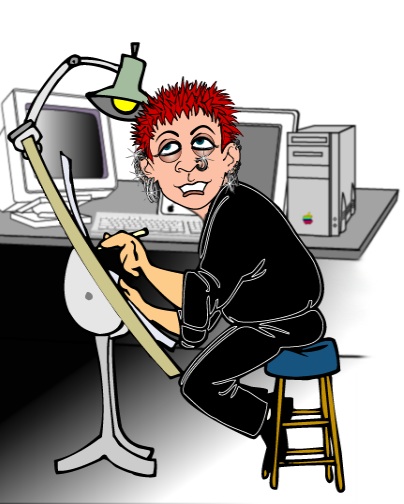 mine as suffering from creative constipation recently. It’s a common complaint, many designers suffer from it and it can be the result of multifarious causes; tight deadlines, the distractions of every-day life, worrying about friends and families, an untidy desk. All of these have been my obstructions at one time or another, preventing my creative juices from running freely.
mine as suffering from creative constipation recently. It’s a common complaint, many designers suffer from it and it can be the result of multifarious causes; tight deadlines, the distractions of every-day life, worrying about friends and families, an untidy desk. All of these have been my obstructions at one time or another, preventing my creative juices from running freely.
Fear of failure is the main culprit though, not just failure in the eyes of others but more importantly, failure to oneself. As a creative I’m cursed by the desire to create, it’s a necessary ablution – required to purge my brain of the incessant busy-ness it experiences on a daily basis. I have important things to say, I need to communicate!
But it’s not just a simple case of drawing, designing or writing just any-old-thing, it has to be good, to mean something, to make sense and, most importantly, to inspire and evoke reaction. This pressure I place upon myself is enormous, it’s enough to make me seize up into a foetal ball – like a anally-retentive hedgehog.
Luckily I’ve discovered ways of dealing with this potentially crippling condition. When a bad case of CC kicks in, the natural response is to sit in front of a computer screen in a frozen state of panic, waiting for that elusive “idea” to formulate. This will never happen. OK, I lied, it might happen but chances are that, if it does, it will be a crappy idea.
In order to free your mind and to come up with the best ideas you just need to get working. If you are a writer, just start writing! Any old rubbish that comes to your mind will do, whether it’s related to the subject or not. The exercise of writing will free you up and you’ll find that eventually you will start to incorporate the subject at hand and little gems will appear amongst the sentences. Once this happens, go over it again, delete the rubbish, elaborate on the good stuff and craft it into something positive.
If you’re a designer or artist, get away from the computer! Pick up a sketchbook and start drawing. If you can’t draw then go out and take some photographs or even Google images for inspiration by typing in key words. Drag what you find into a a document to create a mood board (I use Curio for this as it maintains links to the original files).
If you’re working on a design think about the individual components separately as this can be less intimidating than thinking about the job as one, huge, insurmountable project. Spend an hour playing with fonts, not just fonts on your computer but looking around at shop signs, magazines, anywhere you see type. Tracing letter-forms from magazines can be a great way of “feeling” a font instead of just liking it. Spend another hour with some paint, playing with it, experimenting to find color combinations that please you or convey the feeling you want to get across.
From these experiments your ideas will grow, some will be awful but elements will shine through that you can use in the current, or future projects. The ideal is find time to do creative exercises like these on a regular basis, even when there’s no deadline. Modern life and work pressures make this very difficult but a good employer knows that to get the best out of creative talent, employees need inspiration and time for experimentation. Most creative agencies make sure their staff are looked after fairly well with generous time off (compared to other industries) and a good working environment. (Why do you think most production companies have fridges full of wholesome food, drinks and the odd bit of alcohol?) 🙂
If you’re a freelancer, remember that you are your own employer so don’t be too hard on yourself. Allow time for experimentation and inspiration. Avoid stress, look after yourself and don’t forget to have the odd bit of fun. Finally, once the ideas start coming, enjoy it but don’t get too cocky or over-confident. You want to be freed up by these exercises but not to the extent where you’re producing nothing but a vast quantity of digital diarrhea!
Angie’s track of the day – Free Your Mind – En Vogue
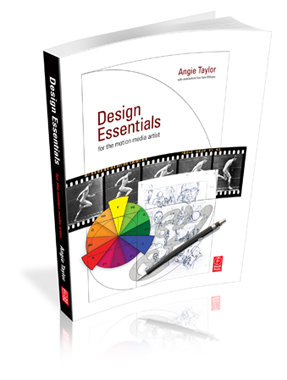
I’ve been busy putting the finishing touches to my forthcoming book, “Design Essentials for the Motion Media Artist“.
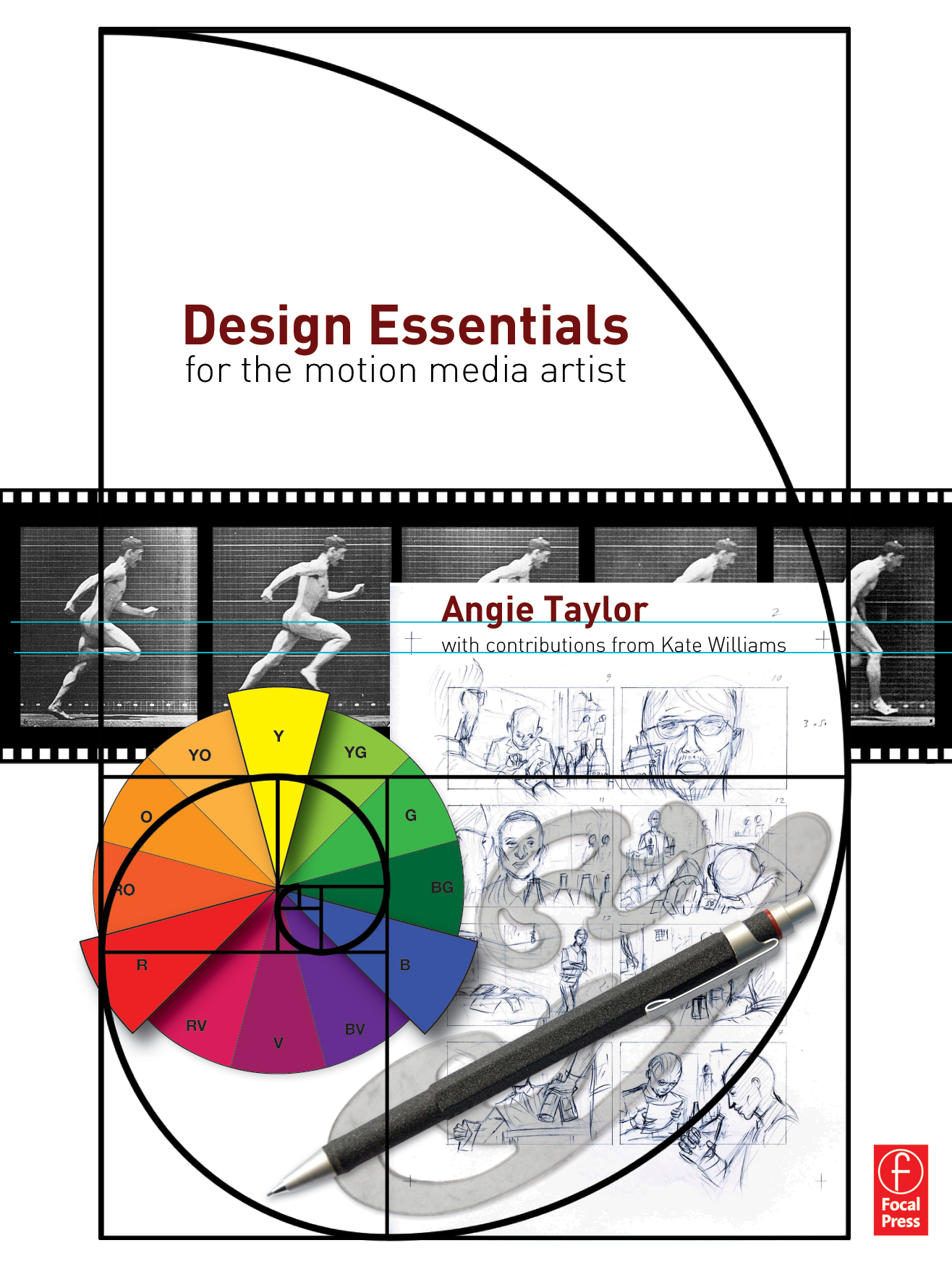
It’s funny, I’ve written books before. Software books, teaching people how to use Adobe After Effects to be specific. I was commissioned to write these books, at the time there were very few books on the subject and there was a growing demand for them. I must say, I hated writing them, the process was so bogged down with technical checking and they had to be written in a very standard, linear way which I found stifling.
I’m pleased to say that this book was different. It’s about the principles of art and design, a subject very close to my heart, something I live and breathe so writing it was very hard work but also, a real pleasure. That is, till it came to illustrating the book. Creating my own images and diagrams was fine, no problem. But when it came time to adding photographs of famous inventors, artists, artworks and examples of motion graphics, the nightmares started.
I tried my best to get clearance for the images, but to no avail. First of all I had to find out who the copyright owners were, this is not as easy as you may think. In some cases several people claim to own copyright so how do I know which one to believe? Even after finding out and writing to them, I’d often get no response. One day I rang the Galleria Nazionale delle Marche in Italy to ask for permission to use a reproduction of The Flagellation by Piero Della Francesca, I greeted them in my best pigeon Italian (which admittedly is pretty poor!) I asked if there was anyone there who spoke English and they promptly hung up on me! This happened three times!
This was an extreme example but fairly typical in that nobody seemed interested in my offers to pay for written permissions to use their work. It seems that everybody wants to protect their work but nobody wants to sell you the rights to use it, so what’s the point in protecting it, what are they protecting it from exactly?
I have no intention of stealing anybody’s work, using it for any obscene publication, claiming that it was mine, all I wanted to do was pay tribute to some of my favorite pieces of work, and their creators. I presumed that copyright was intended to prevent the creators from losing revenue but if they’re not making it easy for people to pay, how do they expect to make any money? It seems very sad that the creative outpourings of artists and designers are surrounded by a cobweb of bureaucracy that prevents them from getting exposure, making money, providing inspiration for others and being shared, loved and developed into the art and design of tomorrow.
Since encountering this situation I have read up on copyright and want to share a couple of really interesting articles on the subject. The Abolish Copyright website explains why this system is so antiquated and has some great links to other articles. Anyone who is planning to provide web content in the UK should read up about the Digital Economy Bill which is being pushed through parliament as we speak. It’s likely to make matters a whole lot worse by propping up and supporting bad business models by giving unprecedented power to private entities to impose sanctions based on suspicion rather than due process. They can even take away your internet access if they suspect you of having copyright items on your website, it’s crazy! But, it’s not too late to act, The Open Rights Group will help you fight this insidious and draconian bill before it’s too late!
Finally, as a celebration of those brave individuals who stick two fingers up at copyright law, and as a tribute to Malcolm McLaren, a true eccentric Englishman who helped change the face of music. Bow Wow Wow‘s fantastic “C30, C60, C90 – Go!” – listen free on Last FM.
 I’m busy preparing to leave on a mammoth journey to San Fransisco to speak at the Macworld 2010 conference for the first time.
I’m busy preparing to leave on a mammoth journey to San Fransisco to speak at the Macworld 2010 conference for the first time.
I’ll be talking about production workflow, specifically broadcast production as that’s where I spent 12 years of my life freelancing as a motion graphic designer/ animator.
I’ll also share some of the challenges I’ve faced in the transition from designer to creative director, and my methods for overcoming those hurdles.
The talk is part of the users conference (session code: US964) and is titled “Creative Video Workflow – From Storyboard to Completion“. It’s taking place on Friday February 12th, between 15:00 – 16:15.
Of course I’ll be talking about the software I use in my everday work, and will share some top tips and tricks. But my main focus will be on my creative processes. How do I come up with ideas? What do I do to make sure my skills are up to date? How to I collaborate with others and manage remote working?
If you’re interested in finding out more use the priority code TWEETMW when you register to get a $15 Expo pass or 15% off of any conference package. Onsite expo passes are $45, so it’s a great deal!
I hope to see you there!
I’m interested in the trend of decoupling going on in the world of TV and film production companies. It’s the world that I used to live in so it’s close to my heart. Decoupling refers to the process of reducing costs to the client by outsourcing some of the work to freelancers or external services, rather than providing them in house. Decoupling offers big opportunities to everyone in our industry from company directors to freelancers and runners, if we can be brave enough to embrace it.
Increasingly, over the past 20 years, production companies have been expected to be flexible, pressurised to increase their skills, enabling them to deliver every possible service and format to their clients. This entails increasing staff to cover all areas of production, extending the capabilities of the company so they can also generate content for new and emerging mediums (web, mobile devices, games etc). The result is increased costs due to wages and also investment in bigger studio spaces.
The inevitable has happened, the work that was plentiful during these times of development has somewhat dried up. Production companies are competing even harder for the same jobs and clients find it harder to differentiate between companies as they all offer essentially the same services. Frustrated freelancers who weren’t finding the right amount of work (or satisfaction from it) started to create their own collectives which for a while injected some new life into the industry but they too have suffered from what I call the “jack of all trades syndrome”. Feeling that they must offer all services in-house, often stretching the capabilities of their employees and making the work suffer as a result.
Of course there are pros and cons with everything in life, this is no exception. On a positive note, decoupling could provide the opportunity to return to an industry where craft specialization matters. Instead of all production companies offering essentially the same services and competing for every scrap of work, each could become king of a particular area, passing work onto other companies when the work is more suited to their specific skill-field. A certain amount of this already goes on within Soho but I really believe this could be extended. It would improve the quality of work, employee morale and confidence within individual companies.
By letting some of their in house designers go and instead using freelancers, companies could open up to diversity, calling on different specialist skills appropriate for each job. It could create healthy competition between freelance creatives but also opportunity to create alliances and a network for swapping skills. In house designers can sometimes find it hard to maintain focus and motivation, so those more suited to a freelance lifestyle could benefit greatly here.
However, I worked as a freelancer in the industry for over 12 years so I know, only too well the challenges that can be faced. Remote working is not easy, you need to be motivated, focused, pro-active and willing to network. Ideas can be harder to develop on your own, it’s amazing how much creative development goes on during breaks around the coffee machine or meetings in the pub after work for production companies. Get rid of your in house team and you risk losing the teamwork that’s so valuable for the development of ideas and a sense of company identity. It can also be hard to find the right people at the right time to work on a production, they may be busy with another company.
On the whole though I see decoupling as an exciting prospect. It increases the unknown to the equation. Risk and uncertainty can be scary but embrace them and you often find new exciting challenges that, combined with a bit of initiative, can be the impetus to creativity in it’s truest sense. I’d love to hear the thoughts of other design professionals about the whole debate associated with decoupling, and also any stories about the challenges associated with remote working. What are these difficulties and how can we find ways of making it work?
 I’m hoping to see a few of you at MacWorld 2010 where I’ll be speaking next year. I love San Fransisco so will be taking a little extra time out to hang out with my old friends, Amacker and Nina at the Lucky 13 bar on Castro. I also hope to catch up with all my other SF buddies, it’s always hard to fit everything in as there are so many people I love in the bay area!
I’m hoping to see a few of you at MacWorld 2010 where I’ll be speaking next year. I love San Fransisco so will be taking a little extra time out to hang out with my old friends, Amacker and Nina at the Lucky 13 bar on Castro. I also hope to catch up with all my other SF buddies, it’s always hard to fit everything in as there are so many people I love in the bay area!
If you’d like to attend you can click on the banner to the left to get a discount. Click on the Register button and then just use my personal priority code, ATAYLOR when you register.
Below are details about the talk I’ll be delivering;
Users Conference US964: Creative Video Workflow – From Storyboard to Completion – Feb. 12, 2010 3:00 PM – 4:15 PM
Angie Taylor will take you on a journey through a typical video project, showing the entire process including the creation of sketches, brainstorms and storyboards, audio production and clean up, editing, and producing the final project. Angie will also discuss how creative professionals can bring unity and clarity to complex creative projects. Aspects of automating time sheets, liaising with clients, auditing jobs and packaging final files for delivery will be explored within this session.
Anyone with personal or professional interests in creating digital videos and working with tools such as After Effects, Flash, Flow, CS4, Illustrator, Photoshop, Premiere Pro, Final Cut Pro and Soundbooth, will benefit from this session.
If you are interested in a streamlined way to look at the digital video process including tips and tricks using various software tools that will help maximize the creative input and minimize the project complexities, then this session is for you!
Angie’s Shuffle Track of the Day: San Fransisco – Scott McKenzie – listen free on Last FM
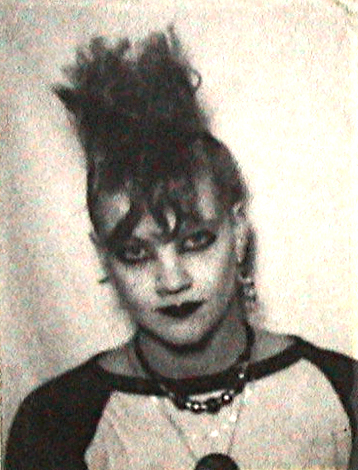
Growing up in Scotland in 1975, I had no idea what was going on the other side of the Atlantic. Little did I know that American “women of punk” were in the process of breaking ground so that people like me could find a voice and be accepted despite our inherent weirdness!
The first woman who I remember having the ideals and attitude that define the category of “punk” was the wonderful and truly original, Patti Smith. I’m sure Patti hates labels as much as I do. In fact the majority of folks labeled “punk” would kick and scream against having it safety-pinned to them. Sadly it’s human nature to feel the need to classify so, Patti, sorry for calling you a punk but please see it as the badge of honor it’s intended to be!
Patti was 29 in 1975, a veteran in punk terms, when she released Horses, her debut ground-breaking mix of rock and poetry. Lenny Kaye, the bands guitarist was also a writer. Lenny has been accused of instigating the use of “Punk Rock” to describe the raw, basic, gut-formed music that was desperately in need of a genre-defining moniker.
Horses is one of my top albums of all time. It fits into my elite category of “albums I never get tired of hearing” (of which there are only about 20). She continues to record and perform today and her recent albums are just as compelling as they ever were. She’s one of those rare individuals who, as well as writing her own fabulous originals (like title-track Horses) can take other artists songs and make them completely her own, take for example her cover of Them‘s Gloria or, more recently, Nirvana’s, Smells Like Teen Spirit.
Patti also had a big influence on the “Punk look”, and on design. She was the first woman I remember seeing wearing a biker jacket, jeans and cowboy boots, just like the guys, and she looked great with her straggly hair and gaunt beauty. She lived with photographer, Robert Mapplethorpe who produced countless iconic images of Patti, including the album covers.
Patti was part of the legendary CBGBs and Max’s Kansas City scene in New York in the the early seventies. The scene was frequented by other great luminaries of the punk scene like Iggy Pop, Velvet Underground, Andy Warhol, The Ramones, Wayne (Jayne) County and of course Debbie Harry who started out as a waitress at the clubs and went on to form 80’s supergroup, Blondie. Debbie Harry brought sex to the Punk Rock movement, most female punks were considered unattractive by regular guys but Debbie Harry toyed with their affections by pouting at the camera, then following this with mocking, teasing gestures. Sadly, partly due to her cuteness, I think she never got the recognition she deserved as a top song-writer and performer. She and Blondie wrote some of the greatest punk love songs of all time including “Picture This“, “Denis“, “Hangin on the Telephone” and “In the Flesh“. After all, punks fall in love too y’know!
Nico became noticed as part of the Velvet Underground/ Andy Warhol scene at the Chelsea Hotel in New York. Her gorgeously, deep, flat vocals can be heard on Femme Fatale, I’ll be Your Mirror and All tomorrow’s Parties as well as others considered to be some of the best Velvet Underground tracks. Although the Velvets can’t really be considered punks their influence on the punk movement can’t be underestimated. People like Siouxsie Sioux had ground broken for them by the likes of Nico with her fusing of 60’s Berlin beatnik, Marlene Deitrich style deep vocals and a passion for the art of singing that can also be seen in the likes of Beth Gibbons from Portishead.
There were countless other acts that influenced me and others, and still continue to do so. Joan Jett was a rock chic of the highest order, as was the Pretenders, Chrissie Hynde. You just have to look at the amazing Alison Mossheart of The Kills, Discount, and more recently, Dead Weather to see their influence carried down the generations.
Without these ground-breaking women we wouldn’t have had PJ Harvey, Kate Bush, Annie Lennox, Madonna, Bjork who are mainstream pop icons of today. And we definitely wouldn’t have any of the women that formed the UK punk scene who we’re going to take a look at in the next installment. I hope you enjoy my little nostalgic trip down memory lane. Please listen to the music and please feel free to chime in if you think I’ve missed anyone!

After receiving good feedback for my blog on the influence of punk on design, I thought I’d keep on subject and write about the women of “punk” who inspired me personally, not just creatively, but in almost everything I do.
I went to see my old friends The Slits last week in Brighton Concorde 2. They were just as amazing as ever, I don’t know how Ari, Tessa and the others have the energy to get up there every night and do their thing, as well as travelling. I was lucky enough to work with The Slits a few years back, producing and directing a live shoot of their gig at the Royal Festival Hall, part of Morrisey’s Meltdown Festival.
It’s funny, I was slightly concerned that it may be a mistake to meet my old punk heroes after so many years (I originally met them briefly in 1979) but I needn’t have worried, they were just as inspiring, revolutionary and refreshing as they ever were. Still continuing to break new ground and fighting against a music establishment that still considers it a novelty when women can write and play innovative and accomplished music.
What I really loved about The Slits, growing up was their originality. They were unlike any of the other “punk” bands. They didn’t seem to want to conform to the usual punk stereotypes of girls in fishnets and bondage clothing, their dress sense and music was taken from a wide range of different styles and cultures, uniquely “Slitsy”.
Their lyrics were confrontational, witty and anti-establishment in the most personal and positive way, they sang songs about the lives that “Typical Girls” led. They, like me, looked as if they would have had trouble “fitting in” before the punk movement came along, I could identify with them. And on top of that, I loved their music, a mix of reggae, dub, punk, soul and all sorts of other influences meant there was nobody else quite like them. Their rendition of Marvyn Gaye‘s “Heard it Through the Grapevine” is still one of my favorite cover-versions of all time.
It was a funny old day, the day of the Brighton gig. I regularly take my niece out on a Saturday morning, we go down to our local beach cafe for breakfast and to talk about life, the universe and everything! And who should we bump into but Ari, Tessa and co having breakfast! So we sat with them and they invited my niece Frankie along to the gig that night.
We all popped along there in the evening and had the best night out ever, The Slits were amazing, the crowd were lovely, lively and very friendly. Ari looked after us well, making sure that we got a safe spot, right at the front so that Frankie, and her friend, Faye didn’t get squashed.
They have a new album out, Trapped Animal, which I haven’t yet heard but has got good reviews. And Island Records are re-releasing their brilliant, seminal album, Cut as part of their “top 50 Island Records”.
So, it’s inspired me to start a series of blogs on women who have inspired me in my work. I’ll start with the ones considered to be “punks” and see where that takes me. Next week I’ll go back in time a little and look at some of my musical heroes from across the pond including Patti Smith and Nico.
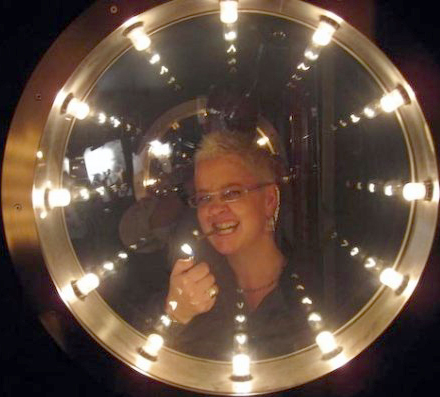
I went to Amsterdam earlier this month, with the Gridiron gang, to attend IBC 2009. I had several meetings to attend, demo’s to do and an interview or two to give. So I packed my suitcase with all my usual accoutrements, everything I would need for a business trip in a distant land! I get especially nervous when packing for a trip like this, what should I bring, and what is it OK to leave behind?
These seem like life-threatening decisions in terms of the anxiety they produce. The bag mustn’t be too heavy, otherwise I may aggravate my old shoulder injury. On the other hand, I mustn’t be caught short in front of my colleagues by forgetting a vitally important piece of equipment. I need to make sure I have backups of every item in case a cable stops functioning, or a hard drive breaks down so I usually pack two of each small item. Bigger items, like my Macbook Pro cannot be duplicated so they are packed in my carry on bag along with other fragile items.
Then there’s the bloody palaver with liquids to contend with! Do I take shampoo, or do I use the crappy ones the hotels provide? And what about conditioner? I’ve just had a fresh bleach-job done on my hair so I’ll need that too. So I pack all the lotions and potions I could possibly need, end up using a very small percentage of them, and then over-packing my bag for the journey home with more bad-quality toiletries pilfered from the hotels, it’s craziness. Plus, I’m always tempted by those cute little 100 ml containers of essential gunk that they sell to us in the airports – Listerine have made a fortune out of me in the last six months!
Anyway, after a day of decision-making, un-making, then re-making. Irritating my partner with “do you think I’ll need this?” every two minutes. I finally decide on the perfectly packaged selection of items and board the plane with a sense of relief. Time for my customary British Airways G&T, I can finally relax. “I’m sorry Madam (I hate being called Madam!) we no longer serve ice and lemon in standard class” I’m told by the air steward. So, my one solitary treat that I allow myself to make the ordeal of packing and flying bearable has now been removed by British Airways and their continual penny-pinching ways. That’s it, the straw that finally broke the camels back, I’ve flown with BA regularly for years but that’s it, no more am I paying a premium for a service that’s no better than the budget airlines. Sorry, digressing but had to get that off my chest! I mean, it’s not a G&T without ice and lemon, really!
years but that’s it, no more am I paying a premium for a service that’s no better than the budget airlines. Sorry, digressing but had to get that off my chest! I mean, it’s not a G&T without ice and lemon, really!
So, finally I make it to Amsterdam and the RAI where I’ve attended IBC, and other events for the last 12 years. I love this city, and it’s people. In fact if I was to live anywhere else in the world than my dear, dear Brighton, it would be Amsterdam. IBC was really good for us at GridIron, we were partnering with Apple on a few events and briefings at the Miranda Pavilion which were very well attended by an excellent, highly qualified group of individuals. We showed Flow and had amazing responses from them. Apple also hosted a party for us at the pavilion where Mark Coleran gave an excellent presentation on his journey from Screen Designer on Holywood movies to becoming the graphical interface designer of Flow.
I also saw some cool stuff, I was impressed by JVC’s HM series of cameras (and I’m a Sony-girl!) These cameras record direct to SD cards in MPEG (for ingest through Log and transfer) or Quicktime for direct drag and drop into the Final Cut Pro timeline. Very nice indeed. Adobe Story looks like an interesting product for scriptwriters, a new market for Adobe, interesting to see how it fairs. Object Matrix is a compelling product that you must see if you’re at all interested in affordable, scalable, secure storage, they make it a piece of cake. And of course the improvements made to Apple’s own Final Cut Studio and Final Cut Server continue to impress.
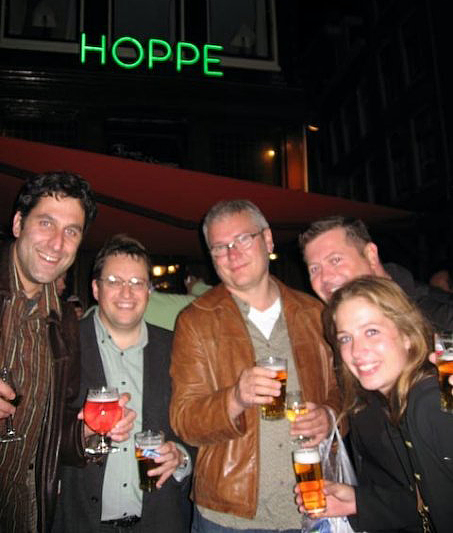
So, of course I came home with a much heavier suitcase, packed with brochures, receipts, giveaways and all sorts of other flotsam and jetsam. That was two weeks ago and I’m only just unpacking now! In fact I’ve done two other events since returning, have stayed in two other hotels and now have two suitcases to unpack! It’s a sorry state of affairs when you have to have rotating suitcases – two cases, each with enough clothing, toiletries and other essentials so that you can leave on a second trip before you feel like you’ve completed the first. I really am a trolley-demo-dolly!
Angie’s shuffle track of the day – Another Girl, Another Planet, The Only Ones – Listen free on Last FM



 I was describing a friend of
I was describing a friend of














